Mixed-media sketchbook journaling is all about layering paints, collage, doodles, and even stuff like ticket stubs or old magazine cut-outs for pages that pop with texture and personality. Try drawing over wild watercolor backgrounds, adding fabric scraps or torn book pages, and sneaking in envelopes for secret notes. Toss in funky photo transfers, overlapping quotes, and stamps for extra detail. Each page becomes a surprise adventure—if you keep going, the ideas just get more unexpected and fun.
Key Takeaways
- Combine painted backgrounds with collage elements like vintage papers, fabric scraps, and ephemera to add texture and depth to your sketchbook pages.
- Layer translucent materials such as vellum, rice paper, or tissue for subtle color effects and intriguing visual layers.
- Incorporate hand-lettered quotes or mixed fonts, layering text over art for added interest and personal expression.
- Experiment with 3D effects using modeling paste, stencils, or stitched fabric to create tactile and visually dynamic surfaces.
- Add interactive elements like fold-outs, pockets, or acetate overlays for surprise layers and extra journaling space.
Layering Paint and Collage Elements
Jump right in—layering paint and collage elements is where sketchbook journaling gets really exciting!
Imagine starting with a splashy base layer of acrylic or watercolor paint to set the mood. Then, grab some cool papers like old book pages or bright tissue; tear, cut, and stick them on with gel medium for instant texture.
Layering techniques come alive when you let each stage dry before piling on the next bit—no muddy mess, just crispy colors and awesome depth.
Don’t be afraid to mess around with translucent materials like rice paper or vellum—they let the colors peek through, like hidden secrets in your art.
Finally, finish it off with doodles, stamps, or gel pen details, pulling everything together in a bold, mixed-media statement!
Drawing Over Pre-Painted Backgrounds
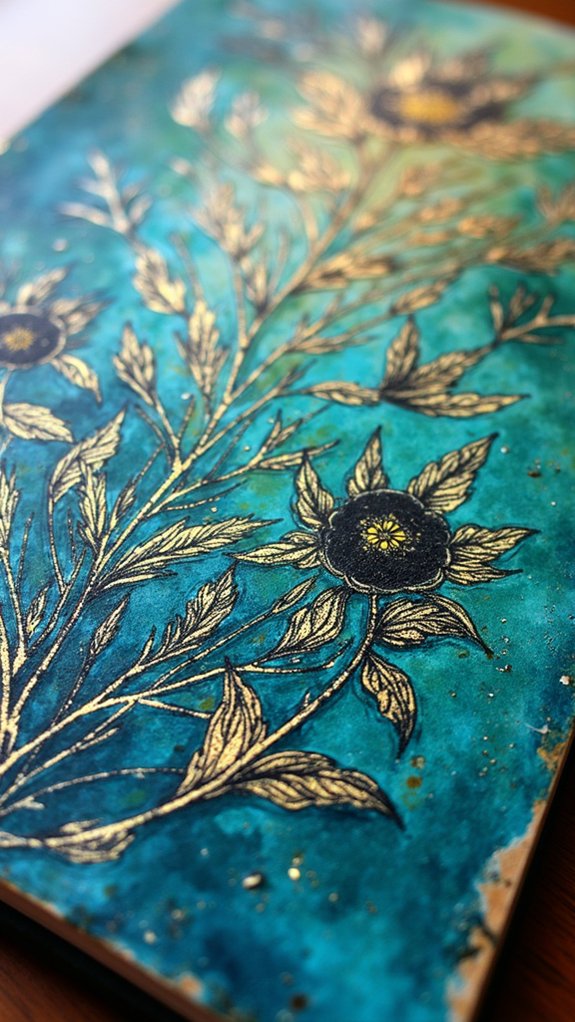
When a sketchbook page is already splashed with color, drawing on top of it can totally change the game—plain old pencil lines suddenly look more dynamic and alive.
In art journaling, those pre-painted backgrounds aren’t just pretty—they add serious energy to whatever you draw next. Whether the page is brushed with watercolors or covered in bold acrylics, every line you add pops in a new way.
Some artists even swipe on black gesso, then draw with white gel pen for that cool, chalkboard effect. Plus, prepping pages in advance means surprise inspiration always has a place to go, no excuses!
- Pencil or ink drawings stand out against colorful backgrounds.
- Watercolor and graphite work well on thick paper.
- Black gesso with white pens creates bold contrast.
- Pre-painted pages speed up spontaneous art journaling.
- Colors and textures help set each page’s mood.
Incorporating Found Papers and Ephemera
Hunting for unique ephemera—like an old movie ticket or a cool postage stamp—can turn even a trip to the mailbox into a creative treasure hunt.
Choosing which bits to include in a collage isn’t just about what looks good; it’s about telling a story that matters to the artist, even if it only makes sense to them and their sock drawer.
Every scrap and snippet has potential, so piecing them together can feel like building a tiny, paper time machine straight onto the sketchbook page.
Sourcing Unique Ephemera Pieces
Ephemera—those ordinary scraps of paper most people toss aside—can turn a simple sketchbook page into something totally magical.
Think about it: concert tickets, old postcards, or a vintage flyer from your grandma’s attic all bring a unique spark to your mixed-media art. To fill your pages with interesting finds, try digging through thrift shops or scouting out flea markets for those hidden gems.
Online spots like Etsy and eBay make it easy to grab cool sets of vintage papers without leaving your couch. Keeping an ephemera journal is a game changer, too—it helps organize all your scribbled receipts and quirky advertisements for quick use.
- Ticket stubs
- Old photographs
- Vintage maps
- Magazine cutouts
- Receipts
Finding ephemera makes every page a surprise adventure!
Meaningful Collage Composition
Because every scrap of paper tells a story, collage becomes more than just art—it feels like building a secret map of memories. In a mixed media sketchbook, meaningful collage composition starts with gathering found papers: ticket stubs, old postcards, maybe that gum wrapper you saved for no reason. Layering textured and patterned pieces creates cool effects, and every new addition makes the page more inviting to touch. Choosing adhesives like Mod Podge or gel medium is key—they hold everything down while letting color and images shine through. Placement is a big deal too! Turn papers at odd angles, overlap them, experiment. Your mixed media sketchbook becomes a lively archive of adventures and everyday wonder.
| Ephemera Type | Texture/Pattern | Possible Placement |
|---|---|---|
| Ticket stub | Smooth, printed | Edge, layered under |
| Postcard | Matte, illustrated | Center, focal point |
| Vintage ad | Glossy, patterned | Corner, overlapping |
| Grocery receipt | Thin, translucent | Middle, peek-through |
| Magazine clipping | Bold, colorful | Borders, accents |
Exploring Paper Cutting Techniques
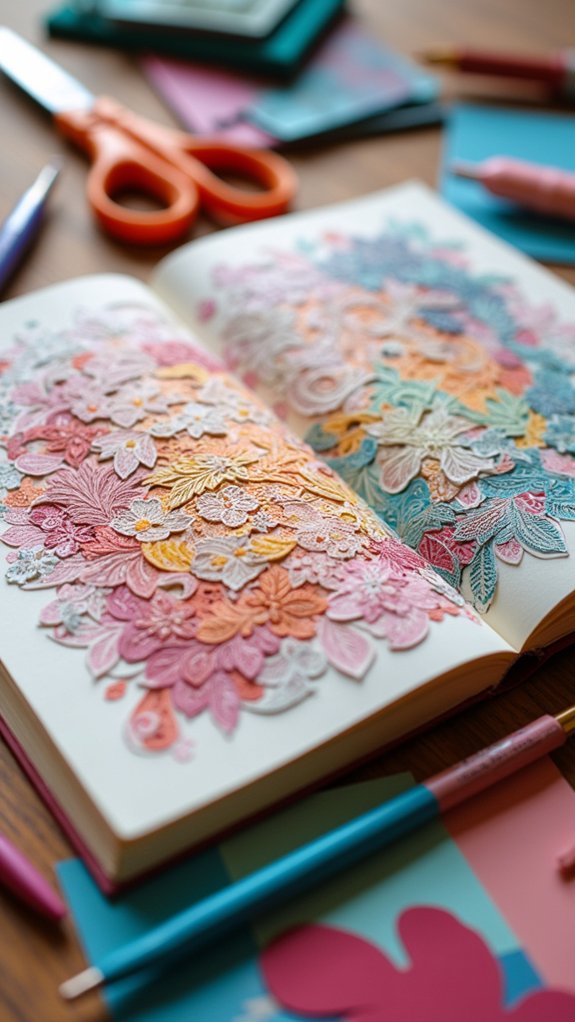
Ever wondered how a piece of paper could totally transform your sketchbook? Paper cutting isn’t just snipping random shapes—it’s an adventure into creating pop-outs, hidden windows, and borders as fancy as grandma’s curtains.
These techniques add depth, making pages feel like secret worlds you’re peeking into. They also make your journal interactive—pages can lift, reveal, or frame surprise sketches. With sharp scissors or a craft knife (carefully, folks!), every cut can form striking designs, from simple patterns to doodly lace.
Try mixing things up with different papers and tools. Here are some ideas to experiment with:
- Layer colored or patterned paper shapes for depth
- Create borders that look like lace
- Design peek-through windows to the next page
- Play with negative space for cool effects
- Try intricate designs using stencils or templates
Using Fabric and Textiles for Texture
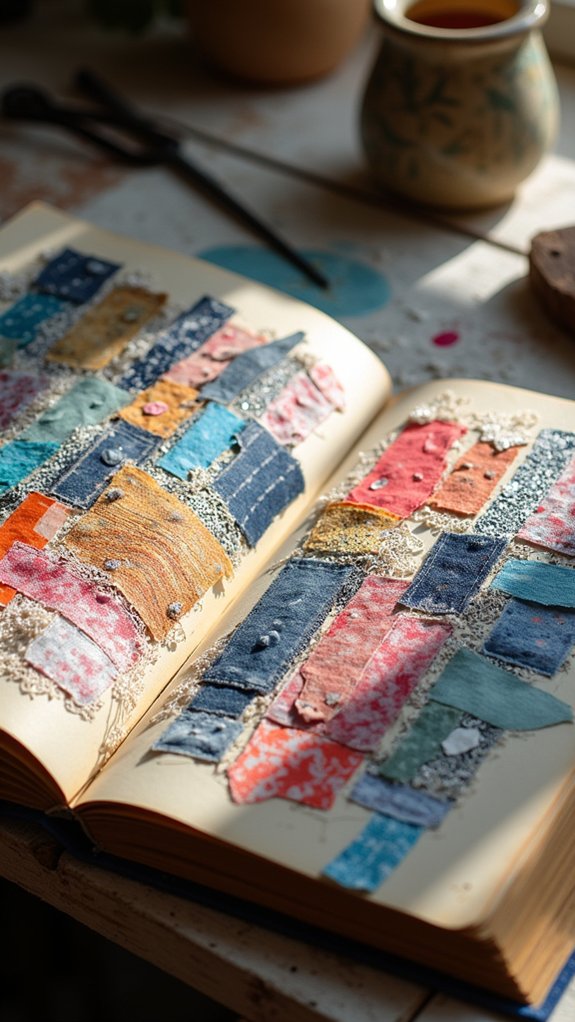
Adding fabric and textiles to a sketchbook might sound a little wild, but it can totally change the look and feel of a page.
Layering bits of fabric—like lace or old t-shirt scraps—brings awesome depth, and stitching on little embellishments can make the whole thing pop with extra flair.
Suddenly, your journal’s not just for drawing; it’s a playground for your scissors, glue, and maybe even your grandma’s sewing kit.
Layering Fabric for Depth
When it comes to making a sketchbook really pop, fabric is like a secret weapon for adding instant drama and depth. Layering fabric on mixed-media pages isn’t just about making things look cool—it’s about inviting your fingertips to explore your art as much as your eyes do.
Think about it: a piece of lace peeking over rough burlap, or sheer cotton creating shadows on a bold painted background. Suddenly, your page isn’t just flat; it’s alive!
Using different adhesives, like fabric glue or Mod Podge, helps your layered fabric stay put, even if you flip back and forth a lot.
Want ideas for layering fabric? Try combining:
- Sheer and opaque fabrics
- Contrasting colors
- Soft vs. rough textures
- Fabric scraps and ribbons
- Overlapping patterns
Stitching Embellishments for Interest
If a sketchbook page ever starts feeling boring, bringing in some stitched embellishments can be a total game changer. Stitching embellishments instantly add texture, making your pages way more interesting to touch and look at.
Mixing in fabrics like cotton, lace, or felt transforms a plain page into a super cool mixed-media masterpiece. Using different stitching techniques—straight stitches, zigzags, even a few creative embroidery moves—lets you create lines and patterns that stand out from boring old paper.
Want crisp lines? Try a sewing machine. Craving that messy, artsy vibe? Hand-stitching is your best friend.
Best part? You can combine stitching embellishments with paint or collage, layering everything together for extra punch. Honestly, thread has never been this fun—or this artsy!
Drawing Directly Over Printed Text

Even though some people might raise their eyebrows at the idea, drawing right over printed text is a bold move that can totally transform a sketchbook page.
It’s a little bit rebel, a little bit genius, and it gives art journals tons of personality. When you layer your doodles or sketches over the words in an old book, those hidden sentences peek through and add meaning—even if it’s just a random grocery list!
For a cleaner look, try brushing a thin layer of paint or gesso first. This technique is also awesome for upcycling, making sure nothing goes to waste. Plus, it’s fun to test different drawing tools over text—think pens, crayons, or even colored pencils.
- Gives pages a unique layered look
- Adds surprise meaning
- Encourages creative upcycling
- Works with lots of drawing tools
- Easy to prepare for sudden inspiration
Creating Textured Surfaces With Gesso or Modeling Paste
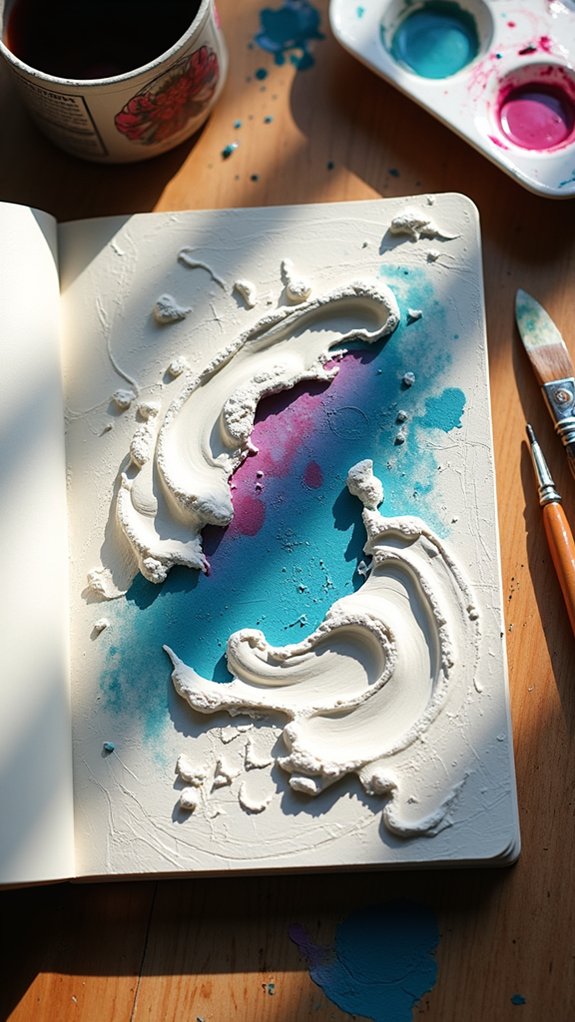
Want to make your sketchbook pages look seriously cool and three-dimensional? Try layering gesso for different effects, or go bold and sculpt chunky shapes with modeling paste—think of it as giving your art a secret base coat or even a wild hairdo.
Just imagine swirling, scraping, or smooshing these materials onto the page, all while dreaming up ways to make your pictures pop right off the paper!
Layering Gesso for Effects
A blank page can feel both exciting and a little scary, but that’s where gesso comes in—like magic armor for your sketchbook!
Layering gesso opens up a whole world of textures and effects, letting artists turn flat paper into a playground of bumps, swirls, and patterns. By adding thin coats of gesso with a brush or palette knife, each new layer bumps up the depth.
Plus, gesso gives paints and inks something to cling to, making colors pop. Want to kick it up a notch? Try using stencils, sponges, or even forks before the gesso dries for extra drama!
Just remember, patience is key—let each coat dry before adding the next. Try these tricks for amazing results:
- Create wavy lines
- Use textured brushes
- Dab with a sponge
- Drag a comb through wet gesso
- Stamp with found objects
Sculpting Forms With Paste
After playing around with layered gesso and making the paper pop with texture, it’s time to test out some real sculpting skills.
Grab some modeling paste—this stuff is like magic frosting for your sketchbook. Want to create fluffy clouds, craggy mountains, or even pretend monster footprints? Just scoop modeling paste with a palette knife or an old spatula and see what happens!
Gesso makes a solid base, and the modeling paste adds all the drama with its 3D pop. Try stenciling, or press in some scrap fabric for wild patterns.
Once your masterpiece dries, hit it with paints or inks. The colors pool in the crevices, making every bump and nook extra cool.
Seriously—your pages will never be boring again!
Mixing Water-Soluble Pencils and Crayons
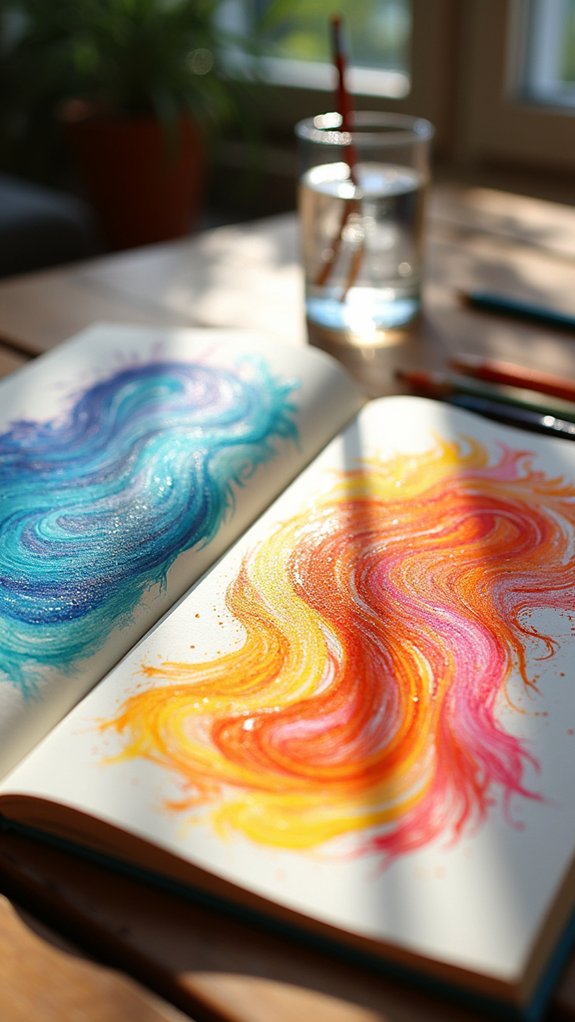
Magic happens when water-soluble pencils and crayons team up in a sketchbook. Suddenly, creating dreamy watercolor painting backgrounds is as easy as scribble, brush, and wait for the magic to unfold.
The real fun starts when the pencils leave sharp, sketchy lines and the crayons lay down rich blocks of color—you just add water, and boom, those marks melt into washes and swirls like a spell. Mixing these tools with acrylics or inks boosts texture, making each page pop with color and life.
Curious about secrets for awesome results? Check these out:
- Layer pencils under markers for cool hidden blends
- Rub crayons for bold, waxy strokes before blending
- Test brands on scrap paper for perfect compatibility
- Add water to soften edges or create watercolor flows
- Combine mediums for unique mixed-media textures
Recycling Old Art Scraps Into New Pages
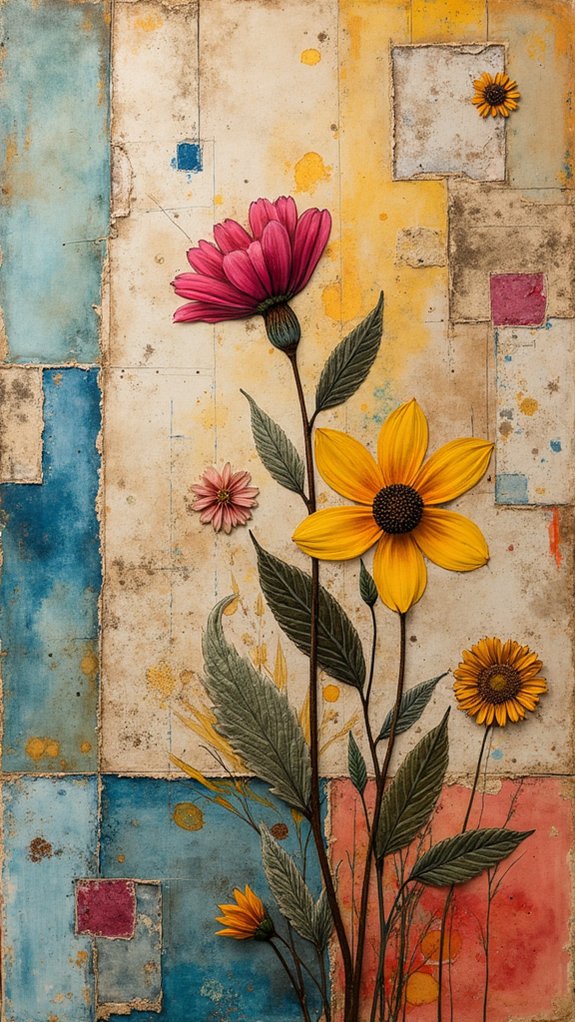
When sketchbooks start filling up with wild experiments and color adventures, something cool happens—there’s always a pile of leftover art scraps just waiting for a second chance.
Recycling old art scraps into new mixed-media pages is kind of like giving those forgotten doodles and half-finished paintings a superhero cape! Snipping or tearing old drawings and paintings, then layering them onto a fresh page, creates texture and adds a surprising twist to any sketchbook.
Not only does this approach keep paper out of the trash, but it also lets every weird squiggle and color explosion become part of a bigger story. Mixing different scraps can lead to wild, unexpected results.
Who knew leftovers could make your artwork even more exciting and creative?
Building Dimension With Fold-Outs and Inserts

Even if a sketchbook seems like it’s just a stack of flat pages, there’s actually a whole world of secret spaces and surprise pockets waiting to happen.
Building dimension with fold-outs and inserts turns any plain book into a mixed-media adventure. Fold-outs create layers that flip, twist, or slide open, letting you design big art or stash fun discoveries. Inserts—like tiny pockets or mini booklets—let you tuck in notes, sketches, or that secret doodle you don’t want your math teacher to see.
Different papers make things pop: cardstock for sturdy flaps or super-soft translucent ones for a bit of mystery.
- Add fold-outs to sides or tops of pages.
- Try different shapes and sizes for inserts.
- Use cool papers for extra texture.
- Hide messages under flaps.
- Combine fold-outs with doodles for surprise!
Adding Transparent and Translucent Materials
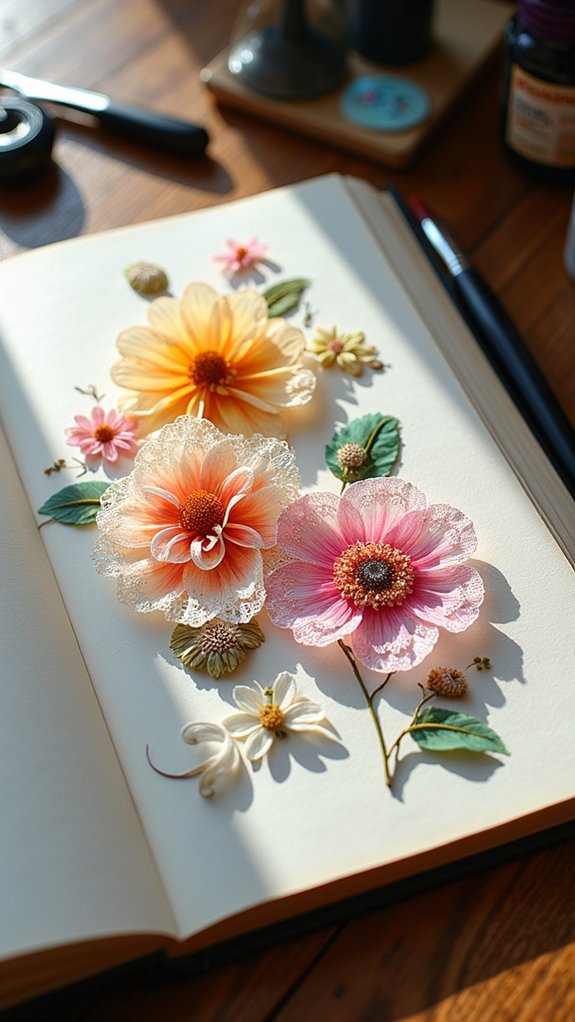
Layering vellum and acetate in a sketchbook is like giving your art a magical cloak—suddenly, your drawings peek through softly, creating a sense of mystery and surprise.
Using tracing paper is another cool trick, letting you copy designs or add see-through textures that change how everything looks underneath.
It’s almost like your sketchbook is wearing sunglasses, and who doesn’t want their art looking that cool?
Layering Vellum and Acetate
Sometimes, the coolest sketchbook pages aren’t just about what’s drawn—they’re about how things are layered and pieced together.
Layering vellum and acetate totally changes up your art game, making pages feel deeper, sort of like secret doors or hidden messages. Vellum softens what’s underneath, giving you ghostly images, while acetate is tough and clear, perfect for overlays with sharp lines or crisp text.
Stack ’em up, and suddenly your sketchbook is like a magic window with multiple scenes. It’s super important to use the right adhesive—because glue splotches are not the vibe.
- Layer vellum over colorful backgrounds to mute and blend colors.
- Add acetate for a glossy, modern look.
- Draw or write on both layers for cool effects.
- Try interactive flaps.
- Use a transparent tape for clean edges.
Using Tracing Paper
Tracing paper is like the secret agent of the art supply world—sneaky, see-through, and totally ready to level up a sketchbook page.
It can be layered onto existing artwork, letting cool shadows and hidden textures peek through without covering up your masterpiece. Try using tracing paper to overlay a sketch, trace patterns, or even add a mysterious floating message—suddenly, your page feels like it’s hiding secrets!
Different adhesives, like double-sided tape or a swipe of glue stick, will keep tracing paper smooth, avoiding that annoying wrinkled look. For extra flair, colored or patterned tracing paper can filter light and add depth.
Combine tracing paper with collage and watercolor, and you’ll get pages with energy, stories, and a playful sense of discovery.
Experimenting With Stamps and Stencils
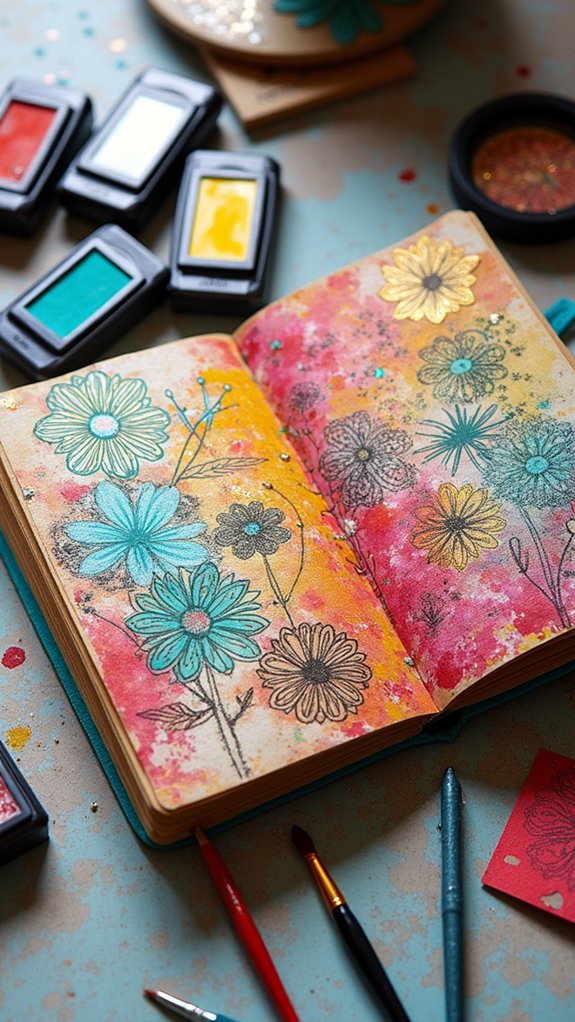
There’s something kind of magical about stamps and stencils—they can totally transform a boring old sketchbook page into a wild jungle of patterns and textures. By experimenting with these tools, anyone can add instant excitement and serious personality to mixed-media pages.
Stamps and stencils let artists play with all kinds of patterns, from leafy vines to geometric designs. Layering them is like stacking different flavors of ice cream—unexpected and awesome! To get the best results, students can mix paints, dab on inks, or use random arrangements for spontaneity.
- Use stamps made from foam, rubber, or hand-carved materials for cool effects.
- Try misting stencils with a little water for sharper paint lines.
- Experiment with layering for endless pattern combos.
- Overlap stencils and stamps for movement.
- Random placement keeps layouts lively!
Playing With Color Blocking and Abstract Shapes
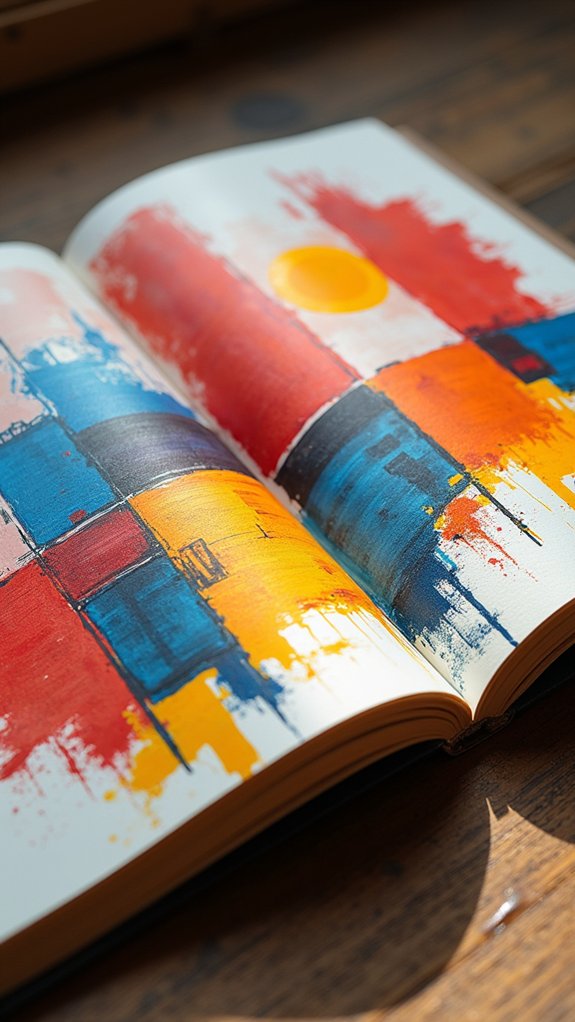
Ever wonder why some sketchbook pages look like they’re exploding with color and energy? Color blocking is a go-to technique for this! By placing big, bold sections of solid color next to each other—think blue squares near bright red triangles—you get instant wow-factor. Abstract shapes make each page unpredictable and way more fun. Use stencils, sponges, fingers, or just wild brush strokes. Plus, layering different textures, like paper scraps or fabric, adds even more excitement. Experiment with color combos: want a wild vibe? Try opposites on the color wheel. Looking for smooth harmony? Go with similar shades. Don’t forget to leave some areas blank—a little negative space helps the color blocks and shapes really pop.
| Idea | Material/Technique |
|---|---|
| Bold Geometric Blocks | Acrylic paint & brush |
| Overlapping Circles | Sponges & ink |
| Torn Paper Layers | Colored paper strips |
| Negative Space Squares | Masking tape & paint |
| Textured Fabric Patches | Scrap fabric + glue |
Combining Handwriting and Typography
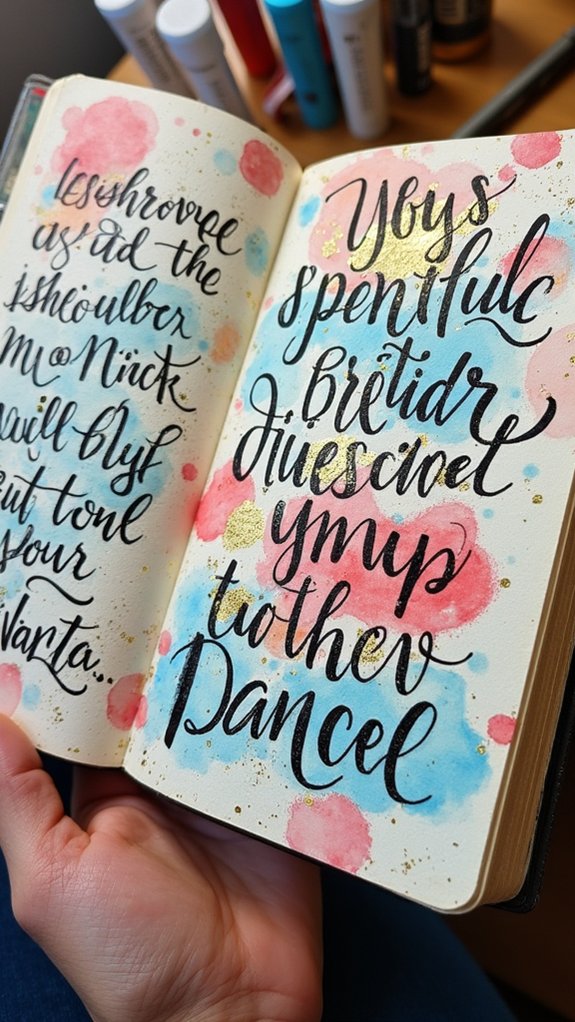
Mixing different fonts and scripts in your sketchbook is like throwing a party for your words—some are bold, some are swirly, and all of them beg to be noticed.
Try layering your text over art or doodles to give the page an extra pop, kind of like secret messages hiding in plain sight.
If you want certain words to shout while others whisper, highlight them with color, decorative outlines, or even funky shadows—suddenly, your lettering has real attitude!
Mixing Fonts and Scripts
A splash of creativity can go a long way when it comes to the words in a sketchbook journal. Mixing fonts and scripts adds an extra layer of fun and unpredictability—think of it like choosing the perfect toppings for your ice cream sundae.
By pairing chunky, bold letters with soft, swooping handwriting, every art journal page feels alive and packed with personality. Artists might switch up font sizes to really shout out important words, and throwing in text from magazines or books adds a quirky twist that keeps things interesting.
Using brush pens and calligraphy markers helps your own handwriting pop out among the typed letters. To keep things looking sharp and not super messy, it really helps to:
- Stick to a color scheme
- Pay attention to spacing
- Mix handwritten with printed text
- Use different pen weights
- Group similar styles together
Layering Text Over Art
There’s something seriously cool about watching words float right over a colorful painting or sketch, like graffiti on a wall where both the message and artwork play off each other.
Layering text over art isn’t just for wannabe street artists; it’s a super creative move that makes any sketchbook page pop. By mixing different styles of handwriting and typography, artists can build a dynamic vibe, almost like the words and pictures are having a pretty intense conversation.
Using transparent paint or a little gesso creates a surface where the text stands out but doesn’t totally bury the background. Swapping out gel pens, markers, or brushes changes up the texture, keeping things fresh.
Quotes, song lyrics, or personal notes work magic, adding a story to the visual chaos.
Highlighting Words Creatively
Bold lettering, sneaky doodles, and wild handwriting can totally shock a boring sketchbook page back to life. Mixing handwriting with cool typography on journal pages turns ordinary words into eye-candy, making everything look way more interesting.
Using giant letters for big ideas, scribbling tiny notes for secrets, or stacking thick and thin fonts? That’s how you make words pop and stories sizzle. Toss in some color—maybe neon pink brush lettering next to a sharp black stencil—and suddenly, even one word can capture all the drama.
- Mix personal script with bold fonts for contrast
- Play with type size to highlight what matters most
- Experiment by layering words over images or blending into the background
- Try colorful ink or paint for extra zing
- Combine brush lettering, stencils, and doodles for unique text styles
Fusing Photographs With Paint and Mark-Making
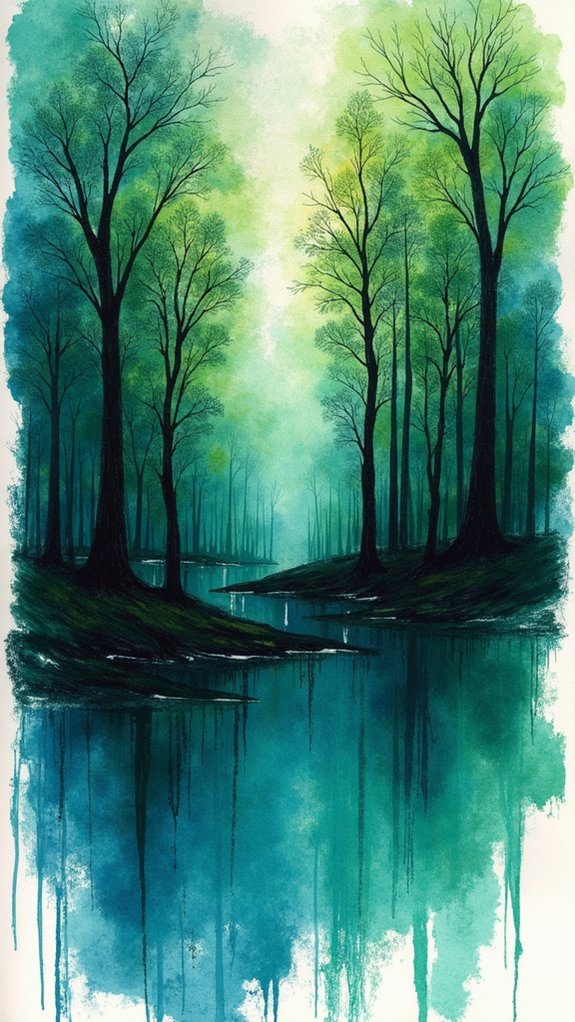
Even with just a regular printed photo, something magical can happen when paint and mark-making tools enter the scene.
Imagine starting with a simple picture and suddenly giving it a whole new vibe using a painted background. First, brushing on a thin layer of gesso will help paint stick better—think of it as prepping your photo for an art makeover.
Layer on acrylic or watercolor paints, waiting for each patch to dry so things don’t get too wild (unless you want wild, of course).
Grab a palette knife, brush, or even the edge of an old gift card to doodle crazy textures. Mix in other bits like collage scraps or ink.
Try some translucent tissue paper for mysterious vibes—so cool, it’s almost like magic.
Attaching Envelopes or Pockets for Hidden Journaling
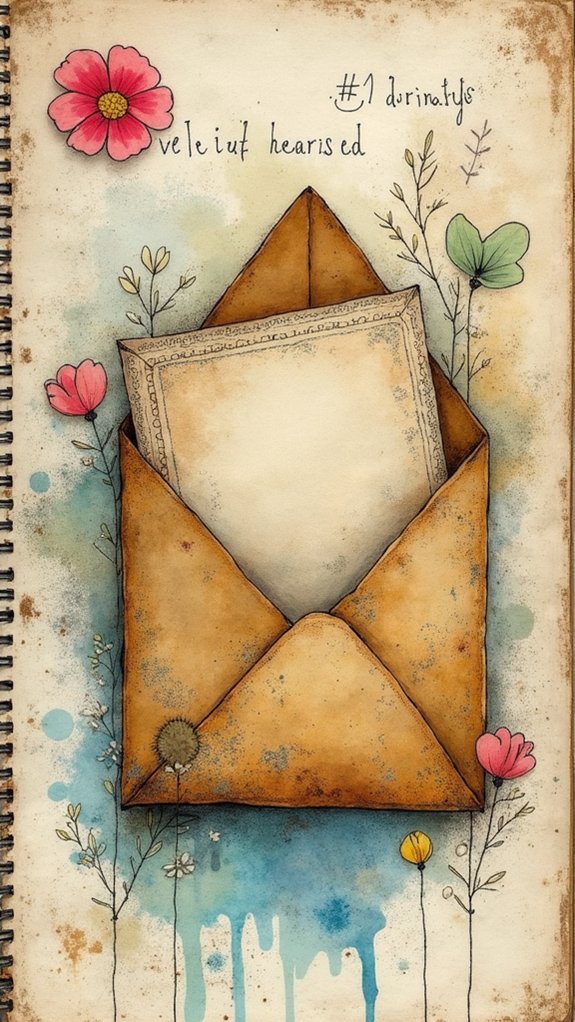
Pictures and paint can seriously amp up a sketchbook, but sometimes a journal page needs a spot for secrets, too. That’s where envelopes or little homemade pockets come in handy—they’re not just for hiding birthday cash!
Adding envelopes to your mixed-media pages means extra space for private notes, secret doodles, or keepsakes you don’t want on display. Crafting these pockets is easy and totally customizable. You can use scraps of paper, bits of cardstock, or even a funky piece of fabric. Just grab some tape or a glue stick and attach your envelope securely.
Don’t forget to make the outside exciting by decorating it!
- Hide thoughts you want to keep private
- Store mementos or tiny sketches
- Add interaction and surprise
- Match the pocket to any page theme
- Decorate envelopes for extra flair
Exploring Seasonal or Nature-Inspired Themes
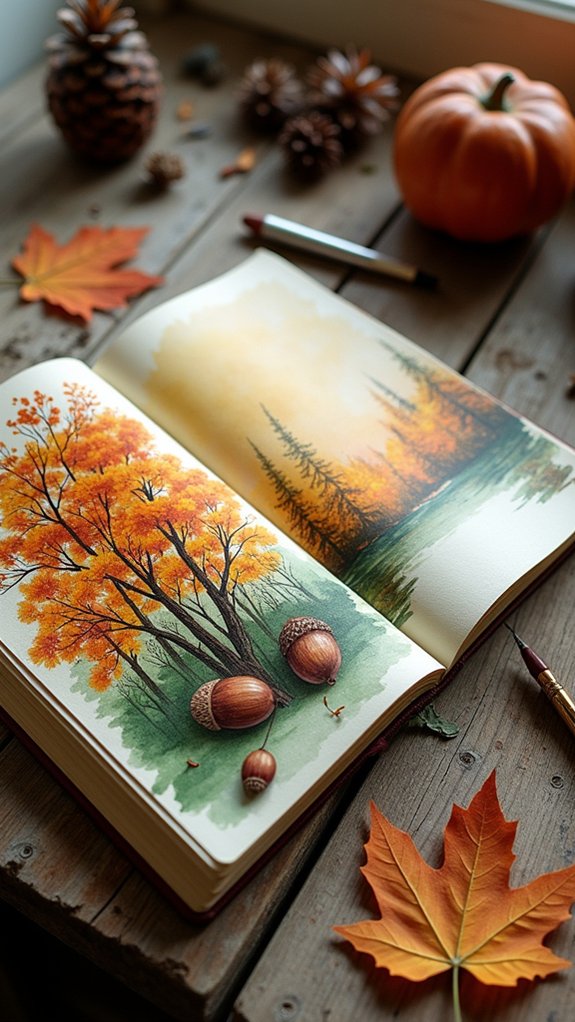
While some people stick to plain pages, others find that bringing in a bit of the outside world can make a sketchbook truly come alive. Seasonal themes are a fantastic way to capture nature’s constant changes.
Picture layering bright green paint for the summer or gluing in crisp, crackly leaves for autumn—suddenly, your page isn’t just art, it’s a tiny world! Pressed flowers, twigs, even pebbles can turn a flat page into something you want to touch.
Picking color schemes for each season—pastels for spring, or icy blues for winter—sets the mood like magic. Extra points if you use textured techniques, like stenciling or magazine collage, for added impact. Each page becomes a celebration of the great outdoors, not just doodles.
Illustrating Quotes or Affirmations
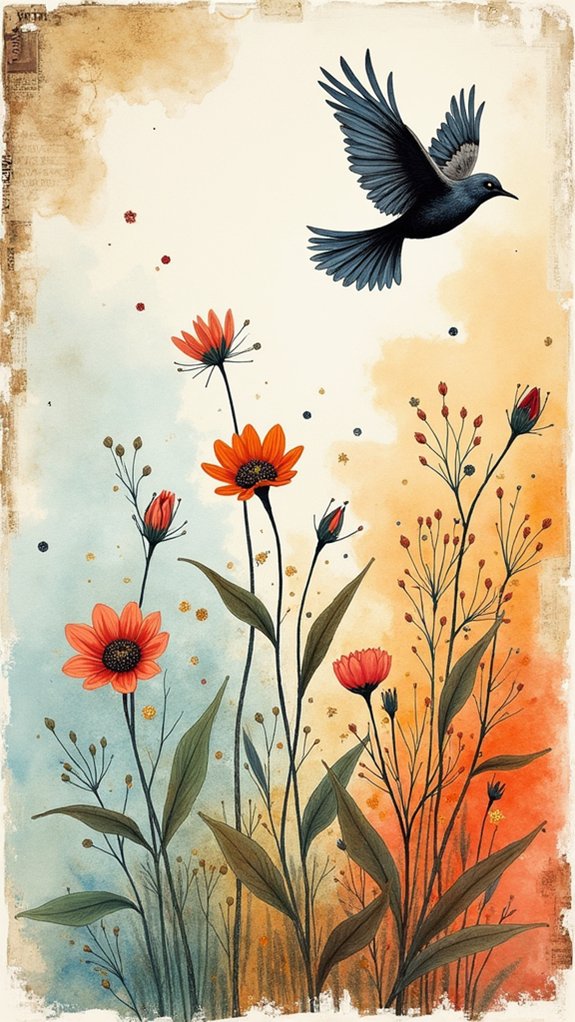
Sometimes all it takes is a few powerful words to turn a regular sketchbook page into something unforgettable. Illustrating quotes or affirmations lets artists take those meaningful words and turn them into creative, mixed-media masterpieces.
Mixing bold hand lettering with splashes of watercolor, textured papers, or bright washi tape adds style and depth. Every material helps highlight the message, and experimenting with new layouts or funky typography makes each quote unique.
Regularly sketching and illustrating quotes gives a sketchbook heaps of personality and can be a major mood-booster, too. Here are some tips to spark inspiration:
- Experiment with bold, playful fonts.
- Layer watercolor backgrounds under your words.
- Frame quotes with textured borders or doodles.
- Use colored pencils for shading and emphasis.
- Combine handwritten text with bright washi tape accents.
Collaging Magazine Cut-Outs and Hand-Drawn Elements
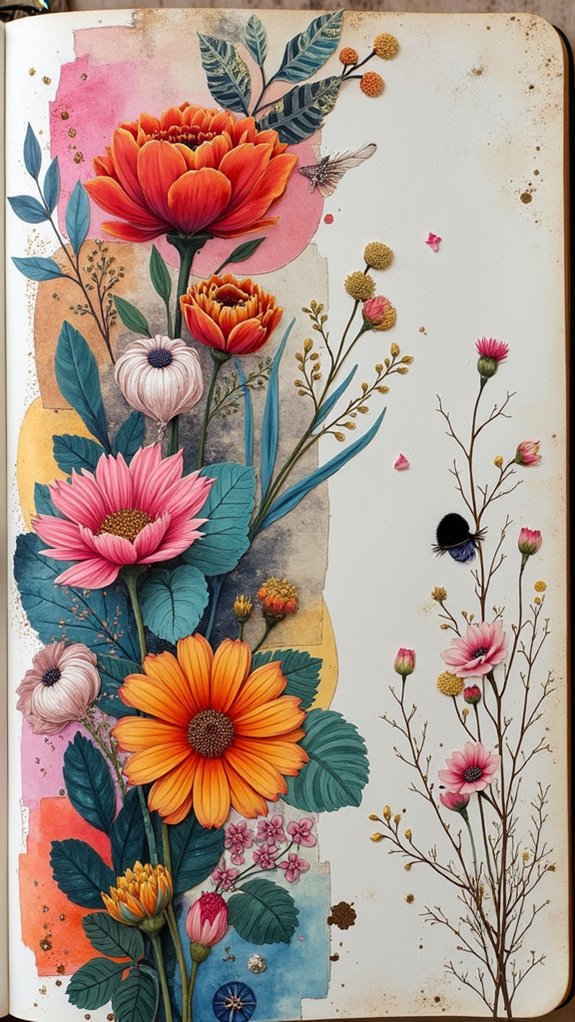
Even with just a stack of old magazines and a handful of markers, anyone can turn a plain sketchbook page into a wild, eye-catching masterpiece.
Collaging magazine cut-outs is like having a museum of images at your fingertips—add a tiny pizza next to your hand-drawn alien, or a famous cat’s face on a superhero body.
When combining cut-outs and hand-drawn doodles, it’s smart to stick to a similar color palette so your artwork feels unified, not like a messy junk drawer.
Found words and phrases from magazines can give hidden messages, sneak in jokes, or build a whole story.
Don’t forget to play with sizes and direction for extra pop!
For lasting creations, use sticky stuff like Mod Podge, and archival pens for drawings.
Frequently Asked Questions
What Is Mixed Media Journaling?
Mixed media journaling is an artistic practice that combines various materials and techniques, such as paints, collage, and writing. It fosters creative exploration by encouraging experimentation, personal expression, and the integration of diverse elements within journal pages.
What Are Mixed Media Sketchbooks For?
Mixed media sketchbooks are designed to support creative exploration, allowing artists to experiment with various materials and techniques in one space. These sketchbooks facilitate artistic growth, encourage spontaneity, and provide a flexible platform for layering, texturing, and visual storytelling.
How to Do a Visual Journal?
Approaching the current question, individuals create a visual journal by combining drawing, painting, collage, and text. They select diverse materials and prompts, fostering creative expression while developing personal style. Consistent practice encourages experimentation and artistic growth.
Can You Use a Sketchbook for Journaling?
The current question explores whether a sketchbook can facilitate journaling. Many recognize that sketchbooks encourage Creative Expression, blending text and imagery. They offer a flexible platform for self-reflection, allowing individual thoughts and emotions to surface through spontaneous, artistic exploration.
Conclusion
With all these sketchbook journaling ideas, anyone can turn a blank page into something wild, weird, or totally wonderful. Maybe it’s messy paint layers, scraps from old magazines, or even a secret pocket for notes—there are no boring rules, just freedom to experiment. If a page gets a little chaotic, that’s half the fun! So go ahead, grab those supplies, trust your imagination, and let every page explode with your personality. Ready to fill that sketchbook?

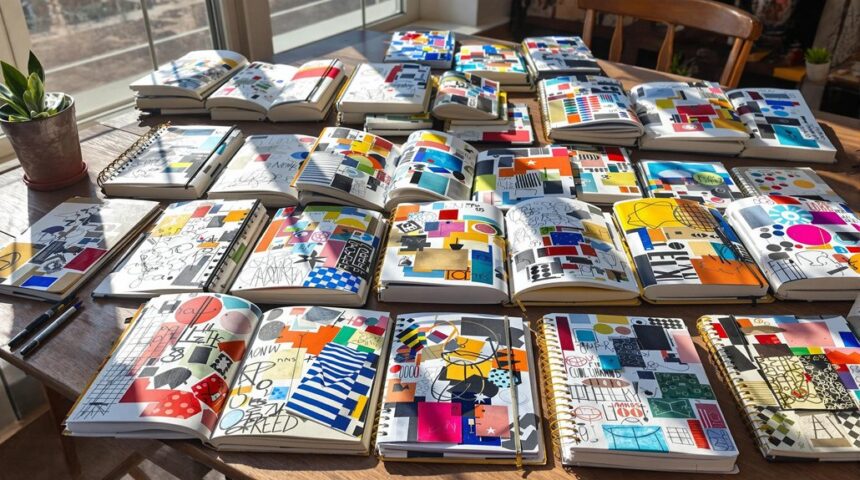
Leave a Reply